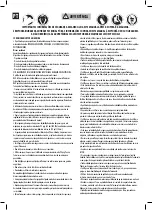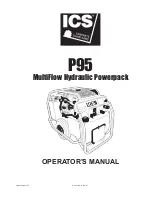
EN
WARNING
IMPORTANT SAFETY INFORMATION ENCLOSED. READ THIS MANUAL BEFORE OPERATING THE MACHINE.
IT IS THE RESPONSIBILITY OF THE EMPLOYER TO PLACE THE INFORMATION IN THIS MANUAL INTO THE HANDS OF THE OPERATOR.
FAILURE TO OBSERVE THE FOLLOWING WARNINGS COULD RESULT IN INJURY.
GETTING STARTED WITH THE MACHINE
• Tyre buffer fitted with scaving tool is only intended for scaving rubber material.
FACOM WILL NOT BE LIABLE IF THE MACHINE IS USED FOR ANY OTHER PURPOSE.
Residual Risks
In spite of the application of the relevant safety regulation and the implementation of
safety devices, certain residual risks cannot be avoided. These are:
- Impairment of hearing.
- Risk of personal injury due to flying particles.
- Risk of burns due to accessories becoming hot during operation.
- Risk of personal injury due to prolonged use.
- Risk of dust from hazardous substances.
THIS MACHINE HAS NOT BEEN DESIGNED TO BE USED IN AN EXPLOSIVE ATMOSPHERE.
The tyre buffer has been designed for professional scaving applications.
DO NOT use under wet conditions or in the presence of flammable liquids or gases.
This tyre buffer is a professional power tool.
DO NOT let children come into contact with the tool. Supervision is required when
inexperienced operators use this tool.
- Young children and the infirm. This appliance is not intended for use by young
children or infirm persons without supervision.
- This product is not intended for use by persons (including children) suffering from
diminished physical, sensory or mental abilities; lack of experience, knowledge or skills
unless they are supervised by person responsible for their safety. Children should never
be left alone whith this product.
This machine and its accessories must be used in compliance with these instructions.
Using it for any other purpose may cause a risk of danger for people and the
environment.
• Always operate, inspect and maintain this machine in accordance with all regulations
(local, state, federal and country), that may apply to hand held/hand operated
pneumatic machine.
• For safety, top performance, and maximum durability of parts, operate this machine
at 90 psig (6.2 bar/620 kPa) maximum air pressure at the inlet with 3/8” (10 mm)
inside diameter air supply hose.
• Exceeding the maximum pressure of 6.2 bar will lead to the risk of danger such as
excessive speed, breaking parts, higher torque or force that may destroy the machine
and its accessories or the part being worked on.
• Be sure all hoses and fittings are the correct size and are tightly secured.
• Don’t abuse hoses or connectors.
• Always use clean, dry and lubricated air at 90 psig maximum air pressure. Dust,
corrosive fumes and/or excessive moisture can ruin the motor of an air machine.
• Do not lubricate machine with flammable or volatile liquids such as kerosene, diesel
or petrol.
• Do not remove any labels. Replace any damaged label.
• The use of a hose whip is recommended. A coupler connected directly to the air inlet
increases tool bulk and decreases tool maneuverability.
• The pneumatic machine must be fitted and connected to the compressed air network
via quick disconnects to facilitate shutdown in the event of danger.
• When the life of the tool has expired, it is recommended that the machine be disas-
sembled, degreased and parts be separated by material so that they can be recycled.
• For multiple hazards, read and understand the safety instructions before installing,
operating, repairing,maintaining, changing accessories on, or working near, the tyre
buffer. Failure to do so can result in serious bodily injury.
• Only qualified and trained operators should install, adjust or use the tyre buffer.
• Do not modify this tyre buffer. Modifications can reduce the effectiveness of safety
measures and increase the risks to the operator.
• Do not discard the safety instructions; give them to the operator.
• Do not use the tyre buffer if it has been damaged.
• Be aware that the failure of the workpiece or accessories, or even of the inserted tool
itself, can generate high-velocity projectiles.
• Ensure that the workpiece is securely fixed.
• Ensure safe clamping of the abrasive product to the tyre buffer.
• Check that the Quick change chuck, as specified by the manufacturer, are used and
are in good condition, e.g. free from cracks and burrs, and are plane.
• Check that the spindle and spindle threads are not damaged or worn.
• Ensure that sparks and debris resulting from use do not create a hazard.
• Avoid contact with the rotating spindle and mounted wheel to prevent cutting of
hands and other body parts.
• Maintain a balanced body position and secure footing.
• For overhead work, wear a safety helmet.
• If the abrasive product becomes jammed in a cut slot, shut off the tyre buffer and
ease the wheel free. Check that the wheel is still correctly secured and not damaged
before continuing the operation.
• Tyre buffer shall not be used over the maximum peripheral speed of an abrasive
product.
• The operator shall pay attention that no bystanders are in the vicinity.
• lnspect the abrasive product before use. Do not use abrasive products which can
(possibly) have been dropped or which are chipped, cracked or otherwise defective.
• Ensure that the abrasive product is correctly mounted and tightened before use
and run the tyre buffer at no-load speed for at least 1 min in a safe position; stop
immediately if considerable vibration or other defects are detected and determine the
cause of these defects.
• Prevent the spindle end from touching the bottom of the hole of cups, cones or plugs
with threaded holes, intended to be mounted on machine spindles, by checking their
dimensions and other relevant data.
• ln cases where flanges are supplied for several types or sizes of abrasive, always fit
the correct flanges for the abrasive being used.
• Avoid direct contact with the inserted tool during and after use as it can be hot or
sharp.
• Store and handle the abrasive product with care in accordance with FACOM
instructions.
• Slips, trips and falls are major causes of workplace injury. Be aware of slippery
surfaces caused by use of the tool and also of trip hazards caused by the air line or
hydraulic hose.
• Proceed with care in unfamiliar surroundings. There can be hidden hazards, such as
electricity or other utility lines.
• Ensure that there are no electrical cables, gas pipes, etc., which can cause a hazard if
damaged by use of the tool.
• Operate and maintain the tyre buffer as recommended in these instructions, to
minimize dust or fume emissions.
• Direct the exhaust so as to minimize disturbance of dust in a dust-filled environment.
• Where dust or fumes are created, the priority shall be to control them at the point
of emission.
• Select, maintain and replace the consumable/inserted tool as recommended in the
instructions, to prevent an unnecessary increase in dust or fumes.
• Working with certain materials creates emissions of dust and fumes, causing a
potentially explosive environment.
• Exposure to high noise levels can cause permanent, disabling hearing loss and
other problems, such as tinnitus (ringing, buzzing, whistling or humming in the ears).
Therefore, a risk assessment and the implementation of appropriate controls for these
hazards are essential.
Summary of Contents for V.TB500F
Page 30: ...EL FACOM j 90 psig 6 2 bar 620 kPa m 3 8 10 m 6 2 bars 90 psig 1 FACOM...
Page 48: ...BG FACOM 6 2 bar 620 kPa 10 mm 6 2 bar 6 2 bar 1 FACOM...
Page 49: ...3 8 x 24 V TB500FQCC V TB500FS V TB500FM FACOM FACOM FACOM FACOM FACOM 1 2 1 3...
Page 54: ...RU FACOM 6 2 620 10 6 2 6 2 1 FACOM...
Page 55: ...3 8 x 24 V TB500FQCC V TB500FS V TB500FM FACOM FACOM FACOM FACOM FACOM 1 2 1c 3...
Page 61: ...NOTA...







































